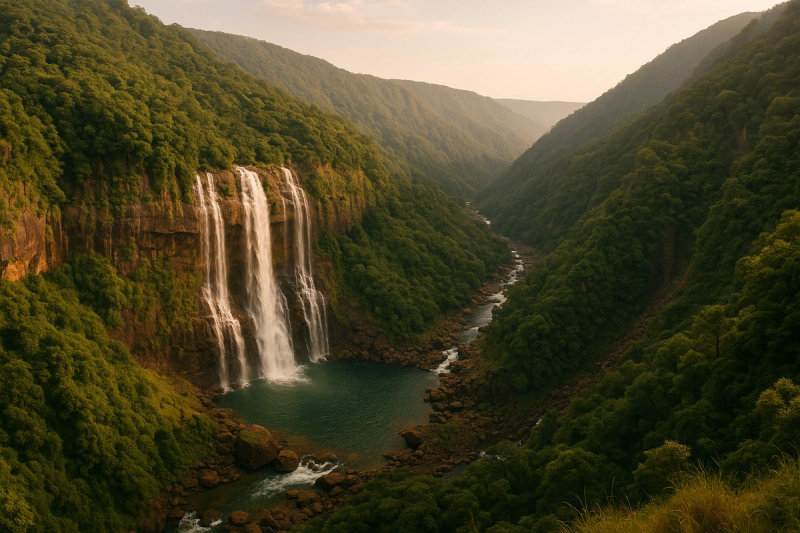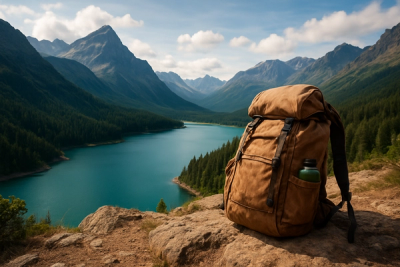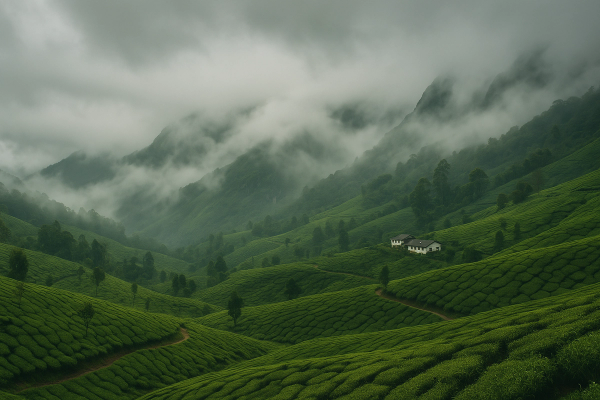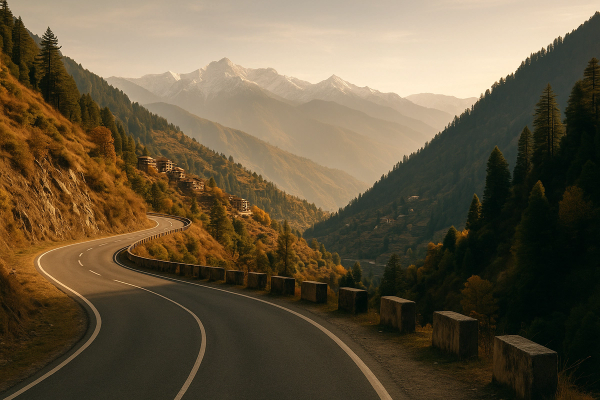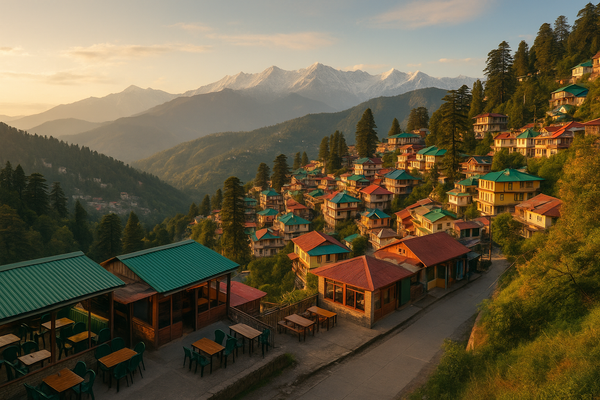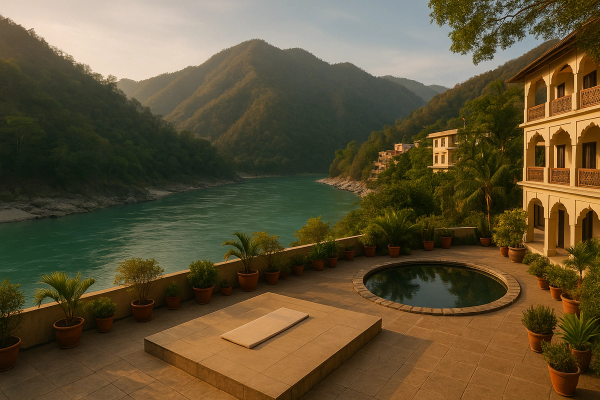Northeast India Hidden Waterfalls: Meghalaya, Mizoram, Arunachal – the trip that washed away my stress, my plans, my shoes (lol)#
I’ve always been that person who’ll detour for a waterfall… like even if it’s a 4 km muddy walk, I’ll go. Growing up in Assam, Northeast wasn’t some exotic far-away place for me, it’s home-ish. But I hadn’t really done a proper waterfall chase across Meghalaya, Mizoram, Arunachal until recently. And wow. I knew it’d be green and rainy and dramatic. I did not expect how many tiny “hidden” cascades are literally sitting off the road, how many ones the locals quietly keep in their back pocket, and how good it feels when cold spray hits your face after a sweaty climb. This post isn’t just a diary. I’ll tell you exactly how I went, permits, money stuff, best months, the kind of footwear that won’t betray you, plus random notes like which chai stall saved me from hypothermia in Tawang.¶
Before you go: Permits, flights, updates (not boring, promise)#
Quick but important. Arunachal Pradesh needs an Inner Line Permit (ILP) for Indian citizens. Super easy online now: eILP portal, usually you’ll recieve an email within hours. Foreign nationals need a Protected Area Permit (different process, allow time). Mizoram also requires ILP for Indians; you can apply online or at designated counters in Aizawl/Lengpui airport. Meghalaya? No ILP for Indians, but some local councils charge small entry/conservation fees at certain sites. Getting there: Guwahati is still the big hub with flights and trains. Shillong has Umroi airport (limited flights, weather-dependent). Aizawl’s Lengpui airport is pretty smooth. And Arunachal finally got Donyi Polo Airport (Hollongi, near Itanagar), which honestly changed the game in 2024/25 for folks flying in. On-ground updates: UPI works in most towns now, but keep cash for remote villages. Mobile signal is fine around Shillong/Aizawl, patchy in Tawang side past Dirang. Road work is constant—monsoon can bring landslides, so leave space in your plan. Don’t be that person who gets stuck and blames Google Maps.¶
Meghalaya: Blue-green pools, bamboo trails, and those ropey climbs down to secret tiers#
Everyone knows Nohkalikai and Krang Suri and yes they’re glorious. But the ones that stuck to me like a leech were the “oh it’s just there, behind the forest” types. Wei Sawdong near Sohra is a proper heart-stealer. The turquoise is unreal—no filter needed, trust me. It’s a steep descent, dusty-bamboo-root kind of trail, with ropes on parts. The local committee manages the path and keeps it clean, so pay the fee (it’s small, like 50–100 per head when I went) and go slow. I went early morning, the pools were glassy, no crowds, and me and him went in like little kids… careful, the rock can be very slippery. Monsoon time it gets dicey; post-monsoon the water colour is peak.¶
Phe Phe Falls in Jaintia Hills—this one truly felt hidden even though it’s popular now among trekkers. Base yourself around Amlarem or ask for the trail via Kudeng Rim village. It’s roughly 3–4 km trek depending on where you start. You’ll hit two major tiers and a bunch of little cascades where locals picnic on weekends. Carry snacks, leave no trash. The path isn’t complicated but it’s wild in parts, and sandals will betray you… please wear decent grip shoes. Another gem: Lyngksiar Falls near Wahkhen. If you’ve done the Mawryngkhang bamboo trek, you’ll know how the community builds these amazing bamboo walkways—it’s similar vibes here, the valley opens up and the falls are layered like a pastry. Go on a weekday, less people, and water clarity is better right after heavy rains settle.¶
- Meghalaya waterfall tips I wish I knew earlier:
- Best season: Oct–Dec for clear, blue pools; Sept–Nov if you like bigger flow. Jan–Feb is lovely too but colder and sometimes lower volume.
- Local guides: Worth it, especially in Jaintia. Fees range ₹400–₹800 depending on trek length.
- Transport: From Shillong, cabs charge by the day (₹3,000–₹5,000 depending on route). Shared taxis exist between towns, but to reach trailheads you’ll often need a hired cab.
- Fees: Many sites charge a small entry/parking (₹20–₹100). It’s community-run, helps with maintenance.
- Respect: No alcohol at the pools, don’t stand on risky ledges just for reels. People do watch and it’s not cool.
- Food: Try jadoh stalls in Shillong/Cherrapunjee, and the smoky pork skewers near Sohra market… heaven.
Mizoram: Vantawng’s silver ribbon and that waterfall you can walk behind#
Mizoram is rolling hills, neat towns, and incredibly polite folks. From Aizawl, I took the road towards Thenzawl—stopped for chai at Hmuifang, where tiny unnamed falls tumble right off the mossy banks. You’ll see them if you’re not rushing, little curtains dropping into ferny pools. Vantawng Falls is the big star near Thenzawl. It’s tall and elegant, viewed from a platform. You can’t access the base easily (it’s protected and honestly safer this way). But nearby Tuirihiau Falls—bro, that’s the fun one. You can literally walk behind the cascade into a cave-ish space. It’s not a huge waterfall, it’s playful and loud and perfect for photos that don’t look fake. Entry fees are basic, toilets were clean when I visited, and the path is clear enough for families.¶
Mizo food is subtle and comforting—bai (vegetable stew), smoked pork, sawchiar (rice and meat), and local pickles that slap. Thenzawl has simple homestays, ₹800–₹1,200 per room, sometimes including breakfast. Always ask about hot water, nights get chilly. Transport-wise, the shared Sumo system connects Aizawl to most towns. Book your seat the day before. ILP is checked occasionally, so keep a photocopy or digital copy handy. Sundays are quiet—many shops shut—plan meals accordingly. People don’t like too much loud behaviour in public, keep it chill. Also, Mizoram’s hills are steep… brakes get warm, patience saves lives.¶
- Mizoram notes that saved my trip:
- ILP: Apply online or at counters. Airport officers are helpful, don’t worry.
- Best season: Oct–March. Monsoon can be beautiful but road closures are a mood killer.
- Connectivity: Good in Aizawl, weaker in smaller towns.
- Food prices: Homestay meals ₹150–₹300, cafe plates ₹200–₹400.
- Entry fees: ₹20–₹50 at many spots, sometimes parking extra.
- Language: English is widely understood, but learning a “khawmma” thank you gets you smiles.
Arunachal Pradesh: thunder and spray in the high hills#
Arunachal hits different. It’s big-sky country. On the Bomdila–Dirang–Tawang route, please leave early because the roads are a zigzag ballet and then some. Nuranang (Jung) Falls is the one that makes you feel tiny. You’ll hear it before you see it. Right near Jang town. The approach has steps down to the river level, and there’s a small hydro setup nearby. If it’s been raining, the spray will soak you in minutes. Bap Teng Kang Falls—locals call it BTK—is gentler, emerald pool vibes. It’s the kind of place where you just sit, listen, and rethink your life choices (in a good way). Permits are checked along the route, and near military zones the rules are strict, so don’t wander off-road. Foreigners, get your PAP sorted ahead. Bum La Pass needs a separate permit from DC office in Tawang, and go only if weather and your body say yes.¶
Dirang’s homestays were my favourite—warm Monpa families, wood-floored rooms, simple meals. ₹1,200–₹2,000 per night, bargaining is okay but don’t push too hard. In Tawang, budget rooms start ₹1,500–₹3,000, upper range ₹4,000+. Food: thukpa, momos, yak cheese if you get lucky, butter tea if you’re brave. Network is patchy post-Dirang and around high passes even BSNL sleeps sometimes. Carry cash. ATM lines get long. Sunrise at BTK with that early golden line on the water… I didn’t expect to tear up but ya, I did. Maybe I’m dramatic but travel does that to ya.¶
- Arunachal survival guide (from someone who underpacked gloves):
- ILP: Do it online, print a copy. Keep hotel bookings handy.
- Shared taxis (Sumo): Book a day in advance from stand offices, seats fill up.
- Acclimatization: Don’t rush to Tawang in one shot. Stop at Dirang, drink water, be nice to your lungs.
- Winter: Dec–Feb gets freezing, some pipes literally freeze. Hot water isn’t guaranteed.
- Bum La Pass: Only with permit + good weather. Carry ID, listen to the officers.
- Festivals: Tawang Festival (around Oct) lights up the town. Ziro Festival of Music is another vibe in Sept (not waterfalls, but worth knowing). - Money-safety-commonsense stuff I actually used:
1) Budget: Daily spend ₹2,000–₹4,000 if you’re doing homestays + local cabs + decent meals, can go lower with buses and shared taxis.
2) Payments: UPI widely accepted in Meghalaya/Aizawl, less in remote Arunachal. Carry ₹5,000–₹8,000 cash for emergencies.
3) Offline maps: Download maps for the whole region. Signal drops aren’t funny.
4) Footwear: Trails are wet. Proper hiking shoes make or break your day.
5) Trash: Carry a small bag. Many spots are community-managed; don’t make them babysit your wrappers.
6) Drones: Check local rules, near military/border areas it’s a hard no.
7) Weather: Landslides happen. Start early, keep buffer hours, don’t argue with the mountain.
8) Health: ORS packets, a small first-aid kit, and honestly, pace yourself. No waterfall is worth blacking out.
When to go (and what festivals might crash your plan in a good way)#
Waterfall-chaser sweet spot across the three: post-monsoon to winter. Oct–Dec is magic—fuller flow from the rains but clearer pools. Sept can be excellent too though sometimes muddy if the rain hasn’t settled. Jan–Feb still awesome for Meghalaya’s blues, colder in Arunachal. Mizoram is comfortable Oct–March. Monsoon (June–Sept) is… complicated. If you love dramatic waterfalls, sure, but landslides close roads and trails get slippery. Keep flexible schedules if you try it. Bonus stuff: Shillong’s Cherry Blossom Festival usually pops up in November, the city turns this soft pink and every cafe is booked. Garo Hills’ Wangala (harvest) in Nov—drums and dance, must-see. Mizoram’s Chapchar Kut often in March—cultural shows, food, craft. In Tawang, local monastery events and the autumn festival bring colour and crowded hotel calendars. Book early if your dates collide.¶
Budget snapshot (because ya, numbers decide lunches vs long treks)#
| Item | Meghalaya (avg) | Mizoram (avg) | Arunachal (avg) |
|---|---|---|---|
| Budget stay (per night) | ₹1,200–₹2,000 | ₹800–₹1,200 | ₹1,200–₹2,500 |
| Mid-range stay | ₹2,500–₹4,500 | ₹1,500–₹2,500 | ₹2,500–₹4,000 |
| Local meals (per person) | ₹150–₹300 | ₹150–₹300 | ₹200–₹350 |
| Day cab hire | ₹3,000–₹5,000 | ₹3,000–₹4,500 | ₹4,000–₹6,000 |
| Shared taxi (per seat) | ₹200–₹600 (within districts) | ₹200–₹600 | ₹300–₹800 |
| Guide fees (treks) | ₹400–₹800 | ₹300–₹600 | ₹500–₹1,000 |
| Permits/entries | ₹20–₹100 (site fees) | ₹20–₹50 + ILP | ₹ILP ₹100–₹200 + site/parking |
Tiny mistakes & lessons (learned the hard way, obviously)#
I once wore old sneakers to Wei Sawdong. Big mistake. Tumbled twice, saved by a friendly Khasi uncle who silently handed me a bamboo stick like, here child, walk properly. Another day, I reached Vantawng late afternoon thinking golden hour will be epic… except the valley was full of mist and it looked like a white curtain. Pretty but not what I imagined. In Tawang I underestimated the cold and my phone died at 20% because batteries hate the chill—keep it in a warm pocket. I also got mildly scolded by a local committee member for letting my feet dangle into a pool where it was restricted (signs are there for a reason). And I learned to eat early on Sundays in Mizoram. Hungry me at 9 pm = sad bread + tea dinner. Don’t be me.¶
If you’re chasing waterfalls in the Northeast, don’t just tick boxes. Sit. Listen to the rumble. Ask a local where their childhood swimming spot is. Half the magic is in unnamed places off the road, where a grandma sells boiled eggs and pepper salt and tells you about that one time the river ran extra wild. I could go back to Wei Sawdong and BTK and Tuirihiau again and again and still find something new. If you want more imperfect, real travel stories and handy guides, I keep peeking into AllBlogs.in for routes and stay ideas. See you on the trail—carry snacks, don’t drop them, and leave the place nicer than you found it.¶

